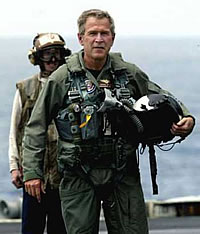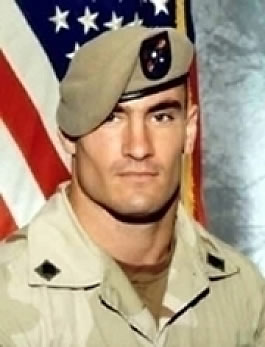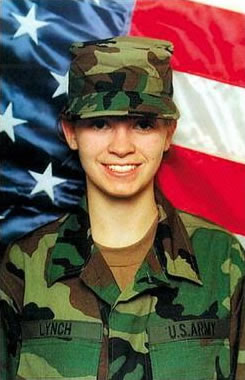Submitted by Robin Andersen on
 Today marks the fourth anniversary of the Bush administration's now-infamous photo op when Bush landed in a fighter jet on the U.S.S. Abraham Lincoln and declared "mission accomplished" in Iraq. His speech was one of many publicity stunts and media manipulations used to sell a fantasy war whose real and very tragic consequences are still being felt.
Today marks the fourth anniversary of the Bush administration's now-infamous photo op when Bush landed in a fighter jet on the U.S.S. Abraham Lincoln and declared "mission accomplished" in Iraq. His speech was one of many publicity stunts and media manipulations used to sell a fantasy war whose real and very tragic consequences are still being felt.
Some of those consequences underwent public scrutiny last week when Henry Waxman, the chair of the House Government Oversight Committee, held hearings titled "Misleading Information on the Battlefield." The hearings featured testimony from Jessica Lynch and the family of Patrick Tillman, two soldiers who themselves were previously used as icons in the fantasy war.
The hearings prompted anger and disgust from commentators like Glenn Greenwald who watched them and wrote:
I defy anyone to go back and read the April and May, 2003 tongue-wagging, mindless American press accounts of Jessica Lynch's epic firefight against the Enemy; the severe gun shot and stabbing wounds she suffered; the torture to which she was subjected while in the Iraqi hospital; and the daring, gun-blazing rescue of her by our Special Forces, and then try to claim that we have a functioning, healthy political press in this country that serves as a check on government deceit and corruption. It is impossible for any minimally honest person to make that claim in light of those stories.
The reality described in congressional testimony starkly contradicted the media narratives through which the public first heard of Jessica Lynch and Patrick Tillman -- two real soldiers who were transformed by the Pentagon image machine into advertisements for the wars in Iraq and Afghanistan. Their stories are stunning illustrations of how gendered myths about masculine valor and a helpless damsel in distress can be called forth to create fictional narratives in the service of war.
 Patrick Tillman was a popular football player with a handsome, chiseled face who walked away from a huge contract with the NFL's Arizona Cardinals to enlist in the Army after Sept. 11th. He was a recruiter's dream and a walking billboard for the military. So when his fellow Army Rangers killed him in an ambush in eastern Afghanistan on April 22, 2004, the Army went into "lockdown mode." They burned his uniform and the body armor that had the bullet holes to prove he had been killed by American weapons. They posted armed guards and effectively stopped the survivors from talking to the press. Instead of dignifying Patrick's life with the truth about what happened, the Army fabricated a hero myth, claiming he was killed by enemy gunfire as he led his team to help another group of ambushed soldiers. They even went so far as to award him a Silver Star for battlefield valor.
Patrick Tillman was a popular football player with a handsome, chiseled face who walked away from a huge contract with the NFL's Arizona Cardinals to enlist in the Army after Sept. 11th. He was a recruiter's dream and a walking billboard for the military. So when his fellow Army Rangers killed him in an ambush in eastern Afghanistan on April 22, 2004, the Army went into "lockdown mode." They burned his uniform and the body armor that had the bullet holes to prove he had been killed by American weapons. They posted armed guards and effectively stopped the survivors from talking to the press. Instead of dignifying Patrick's life with the truth about what happened, the Army fabricated a hero myth, claiming he was killed by enemy gunfire as he led his team to help another group of ambushed soldiers. They even went so far as to award him a Silver Star for battlefield valor.
For years Tillman's family has been kept in the dark about the details of his death, struggling unsuccessfully to find out who fabricated the story. But why Patrick's death was fabricated is far easier to understand, as his brother Kevin told representatives at the congressional hearing: "Revealing that Pat's death was a fratricide would have been yet another political disaster in a month of political disasters ... so the truth needed to be suppressed." It was the same month the horrifying pictures of Abu Ghraib were widely published and shocked the world. America needed to celebrate a hometown hero of mythic purity to counter the seedy images of real American brutality. Patrick's mother Mary also testified at last week's congressional hearing and said her family members were "absolutely appalled" when they realized the extent to which they were being misled. "We've all been betrayed.... We never thought they would use him the way they did."
The tale of Jessica's Lynch's capture and rescue the year prior to Tillman's death was another daring feat of fiction, and equally important to the war effort. As Jessica Lynch herself courageously told congressional investigators, the "story of the little girl Rambo from the hills who went down fighting" was a lie. Unlike Patrick Tillman, she lived to tell at least some of her story herself, but she admitted she is "still confused as to why they chose to lie and tried to make me a legend." To explain why, and in this case how she become a legend, we need to go back to "initial combat operations," to the middle of the invasion of Iraq when a blinding sand storm had stalled the push into Baghdad.
Shattered Illusions
On the afternoon of March 23, 2003, the Arab-language TV network Al Jazeera aired video footage of the bloodied bodies of dead American soldiers sprawled carelessly on a slab floor. With the capture and killing of Americans, the war had suddenly become a problem. Almost overnight, the tone of media coverage flipped from what CNN's Aaron Brown admitted was a "gee whiz" attitude to a tempered anxiety about "another messy, frustrating combat situation." By Tuesday, March 24th, the New York Times noted, "An image of awesome American firepower had been replaced by pictures of vulnerability."
To bolster morale, Fox News featured "public diplomacy" veteran Oliver North, embedded with the Marines in the Iraqi desert. Sean Hannity told North on April 1, 2003, "There's a lot of negative reporting out there Ollie." But the Marines have gone "so far, so fast, with so few casualties, all the munitions you need, all the supplies you ever wanted, all the gasoline. When people hear it from you, because you're there, it means more than anything I can tell them." As Hannity spewed positive spin, the Pentagon Combat Camera crew prepared for the rescue of Jessica Lynch.
Saving Private Lynch
 What the war needed at that moment was a stunning plot reversal to propel the war forward. In the wee hours of the morning on April 2, the military provided the much-needed heroic device (with middle-of-the-night footage): the rescue of Private Jessica Lynch was announced to reporters at a 2:00am briefing at Central Command in Qatar. The young Private had been plucked from a Nasiriyah hospital by a crack commando unit that carried her to safety in a waiting Black Hawk helicopter. Greenish night-vision video taken by a member of the rescue team was aired for journalists the following morning. The gripping story was ubiquitously described as a "daring raid" (e.g., CNN 4-8-03; NBC 4-6-03; ABC 4-7-03). For CBS (4/11/03), it was "a story for history, Jessica comes home." CNN (4-1-03) declared, "it was such a lift." As Time magazine put it (4-14-03), the story "buoyed a nation wondering what had happened to the short, neat liberation of Iraq." "Hollywood," the magazine asserted, "could not have dreamed up a more singular tale."
What the war needed at that moment was a stunning plot reversal to propel the war forward. In the wee hours of the morning on April 2, the military provided the much-needed heroic device (with middle-of-the-night footage): the rescue of Private Jessica Lynch was announced to reporters at a 2:00am briefing at Central Command in Qatar. The young Private had been plucked from a Nasiriyah hospital by a crack commando unit that carried her to safety in a waiting Black Hawk helicopter. Greenish night-vision video taken by a member of the rescue team was aired for journalists the following morning. The gripping story was ubiquitously described as a "daring raid" (e.g., CNN 4-8-03; NBC 4-6-03; ABC 4-7-03). For CBS (4/11/03), it was "a story for history, Jessica comes home." CNN (4-1-03) declared, "it was such a lift." As Time magazine put it (4-14-03), the story "buoyed a nation wondering what had happened to the short, neat liberation of Iraq." "Hollywood," the magazine asserted, "could not have dreamed up a more singular tale."
Doubts about the story's authenticity were first raised by the London Times (4-16-03), which reported that Lynch's rescue "was not the heroic Hollywood story told by the U.S. military, but a staged operation that terrified patients and victimized the doctors who had struggled to save her life." Based on interviews with hospital personnel, including Dr. Harith al-Houssona, the doctor who attended Lynch, the Times account described a terrifying assault in which soldiers handcuffed and interrogated doctors and patients, one of whom was paralyzed and on an intravenous drip.
By May the British Broadcasting Corporation (BBC2 5-18-03) had thoroughly investigated the incident and concluded that, "Her story is one of the most stunning pieces of news management ever conceived." Though the assault met no resistance, as Iraqi and Baath leadership forces had fled the city the day before, the action was staged by the US military. "It was like a Hollywood film. They cried 'go, go, go,' with guns and blanks without bullets, and the sound of explosions. They made a show for the American attack on the hospital -- action movies like Sylvester Stallone or Jackie Chan."
During last week's hearing before the House Government Oversight Committee, the committee's senior Republican member, Rep. Tom Davis of Virginia, argued in his opening statement that the Lynch rescue was exaggerated by the media, not by the military. It is certainly true that the media did embellish the story, but the story itself was created by the military. No embedded journalist accompanied the raid, and the green night-vision footage of Lynch's rescue was shot by soldiers. As Robert Scheer later noted, "The video was artfully edited by the Pentagon and released as proof that a battle to free Lynch had occurred when it had not."
As the BBC noted in its report on the staging of Lynch's rescue, "The Pentagon had been influenced by Hollywood producers of reality TV and action movies, notably the man behind Black Hawk Down, Jerry Bruckheimer." Indeed, one officer quoted in Time expressly compared the film to Bruckheimer's movie. The rescue, he said, "worked perfectly. It was like Black Hawk Down except nothing went wrong." Like so much of the Bush war rhetoric that was patterned after entertainment fictions, the media would legitimate their own narratives.
The irony is that the Iraqi doctors had worked hard to save Lynch's life, but when they attempted to deliver her to a U.S. outpost the day before the raid, the Americans fired on the ambulance driver, making it impossible to proceed. Following the CentCom briefing, the Washington Post headlined its story, "She was Fighting to the Death" and reported that she had sustained "multiple gunshot wounds" and was later stabbed by Iraqi forces. Only later would it emerge, as Lynch testified this week, that she "was neither shot nor stabbed, but rather suffered accident injuries when her vehicle overturned."
Pentagon Propaganda and Militainment
Henry Waxman is right to investigate this incident because it demonstrates how war propaganda was reinvented for the endless war on terror. The rescue of Jessica, a classic damsel in distress story mixed with Black Hawk Down's, "no soldier left behind," provided the tale of heroism and patriotism needed for boosting morale and public support for the war.
The hearings in Congress coincided with the release of a new documentary by Bill Moyers, titled "Buying the War," which supplied its own searing indictment of media complicity and the failure to offer independent information before the invasion of Iraq. It should not be surprising that Sean Hannity is still at his post, now railing against Moyers and telling viewers that their tax dollars are being squandered to pay for Moyers' documentary. However, the propaganda about Patrick Tillman and Jessica Lynch that was produced by the Pentagon and paid for by American tax dollars to "bolster their morale" has been far more costly.
Like Patrick Tillman, Jessica Lynch was used to promote a war that -- like all war -- has left horrible wounds. She walked slowly up to the microphone to read her testimony: "I suffered a six inch gash in my head. My fourth and fifth lumbars were overlapping causing pressure on my spin. My right humerus bone was broken. My right foot was crushed. My left femur was shattered. ... Today I continue to deal with bladder, bowel and kidney problems as a result of my injuries. My left leg still has no feeling from the knee down and I am required to wear a brace so that I can stand and walk."
The media loved the pro-war image of Jessica that it created, but like all the wounded veterans that have been ignored for so long at a Walter Reed hospital, the injured are shunned when they embody the horrors of war. Their painful narratives are told only under the spotlight of investigation.
Billions of dollars continue to be poured into the black void of death and sorrow that was once the country of Iraq. For their public testimony, we can thank Jessica Lynch and Kevin and Mary Tillman. Four years into the sad misadventure in Iraq -- and more than five years into the war in Afghanistan -- the public deserves better than the vacuous "militainment" that brought us "mission accomplished" and a host of other lies wrapped in mythic imagery. Exposing the fantasies that got us so deeply mired in the twenty-first century quagmire of American militarism is the only way to find our way out, and avoid similar tragedies in the future.
Robin Andersen is the Director of Peace and Justice Studies at Fordham University. Material for this essay was drawn from her recent book, A Century of Media, A Century of War.

Comments
Ömer Coskun replied on Permalink
Ömer Coskun